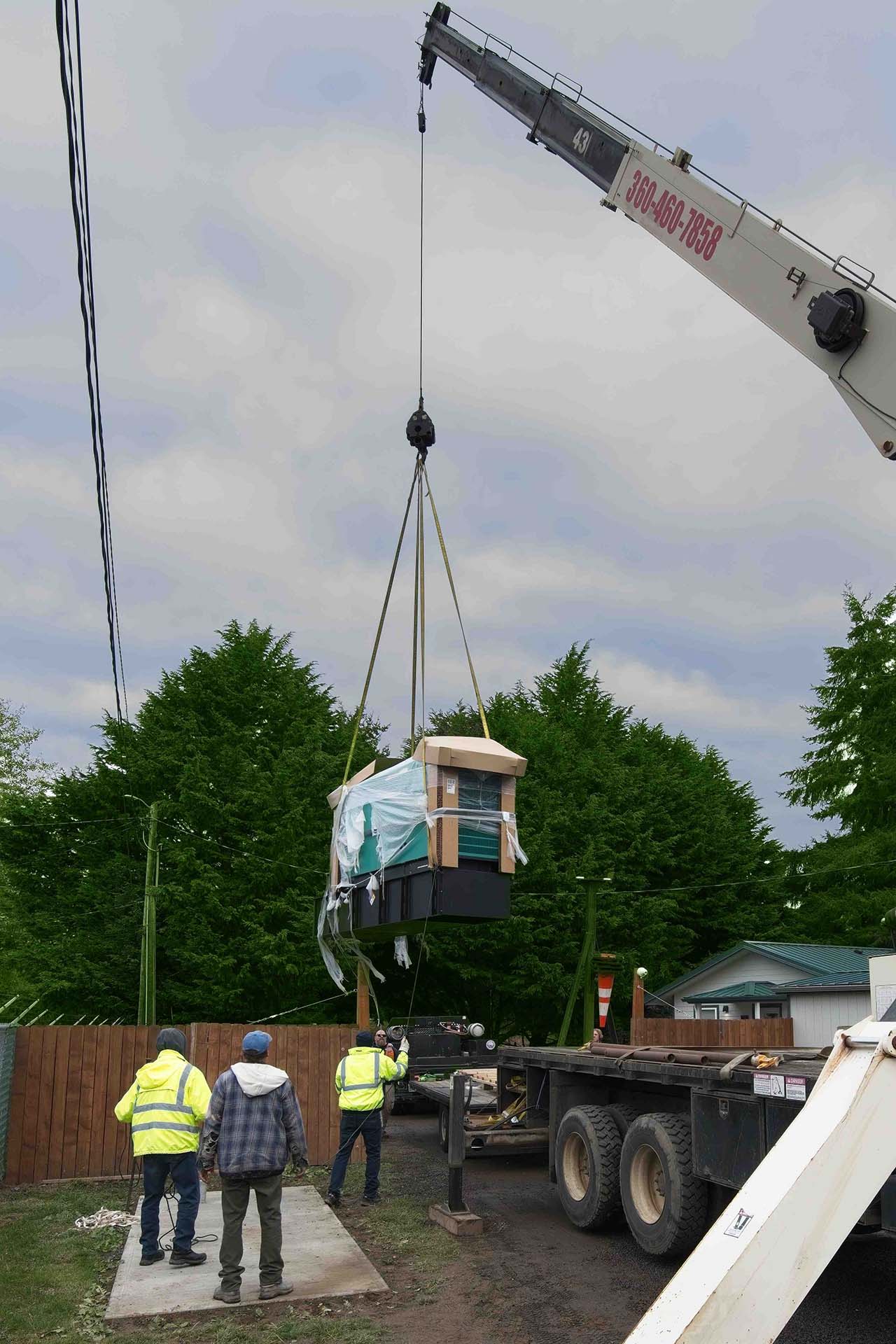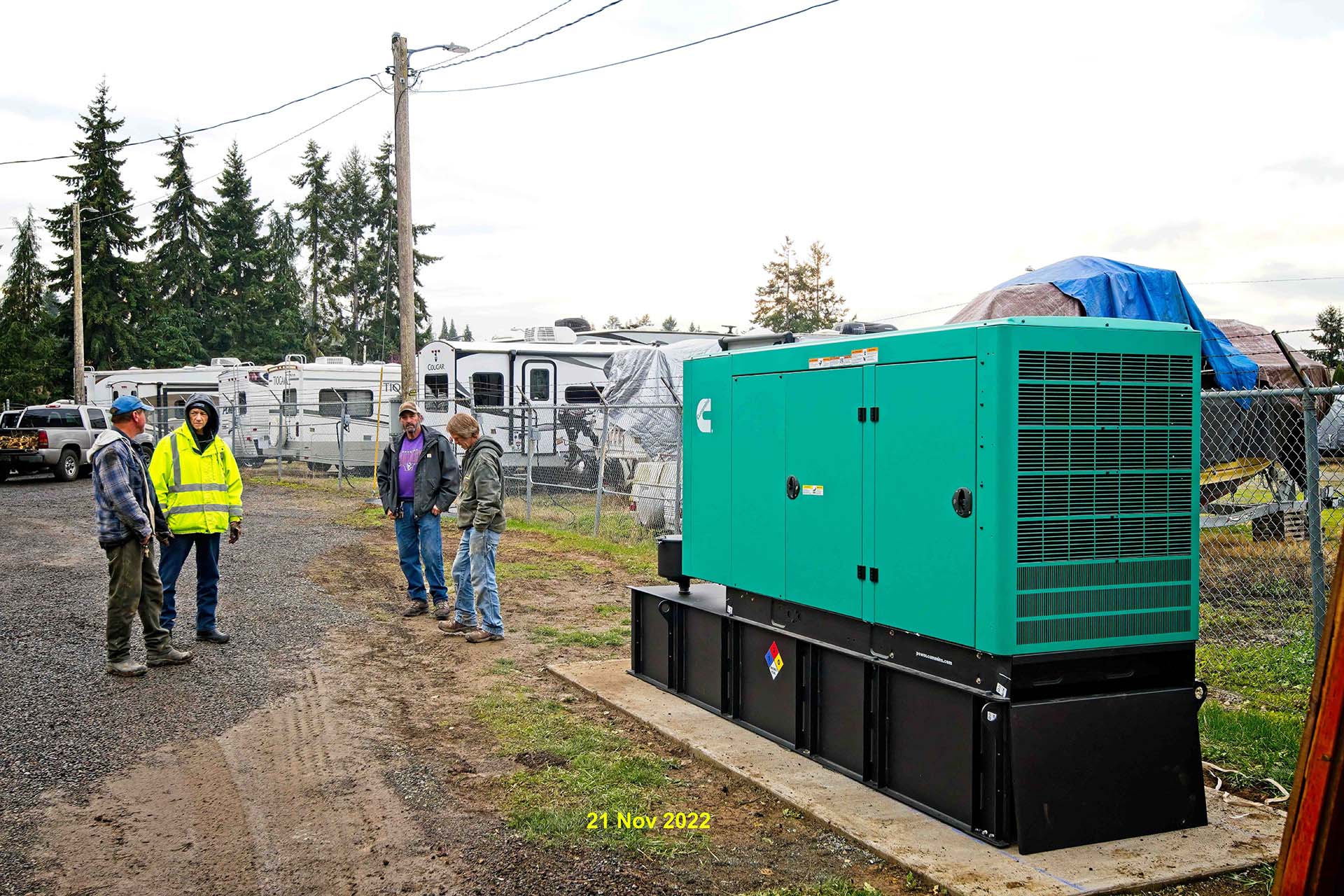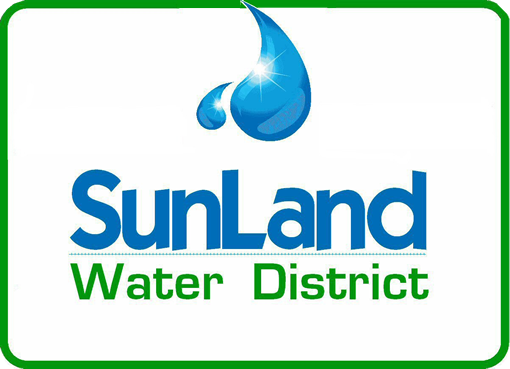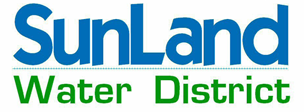
News & Current Issues
PUBLIC FORUM:

New Lower Reservoir Emergency Generator Installed
Emergency generators are critical to the operations of the SWD. When PUD power fails, the emergency generators kick in to provide the necessary power to maintain operations. The lower reservoir holds 140,000 gallons pumped from the well. The Emergency Generator provides power to keep an adequate level of water stored in the reservoir and to provide power to the booster pumps supplying water with adequate water pressure and fire flow to SunLand homes. Our new Cummins generator for the lower reservoir, located near our office at 5762 Woodcock Road, arrived in early December 2022. It replaces a WWII destroyer generator that served the District well but could no longer be maintained.
Fawnwood Lift Station Replaced
The Fawnwood Lift Station is a critical piece of the SWD’s sewer collection system infrastructure. It collects and pumps the waste of 52 homes to the Main Lift Station on its way to the Water Reclamation Facility for processing. The original lift station has been in service since Division 8 was developed. It has performed very well until this summer when pump run times essentially doubled, indicating they were nearing the end of their life cycle. SWD’s maintenance team removed and inspected the pumps and found nothing other than they were old and had lost 50% of their pumping capacity. After outside contractors and the SWD team installed the new lift station in August 2024, pump run times have been cut in half and are back to previous norms.

SUNLAND EMERGENCY PREPAREDNESS – WATER & SEWER SERVICES
Events which could impact water and sewer services in SunLand:
- Power outage
- Fire
- Earthquake
- Tsunami
Emergency power generators should keep the water and wastewater infrastructure going. The sewer lift stations are yet to be fitted with automatic emergency generators so it is prudent to use sewer services sparingly sewer services in the event of an emergency.
The SWD will attempt to communicate with homeowners via the One-Call-Now system in an emergency.
In any emergency event, having a few gallons of water stored in the garage or basement is wise; along with a few empty containers with lids in case you need to go get water and bring it home.
For the SunLand Water District’s Emergency Response Plan, click here.

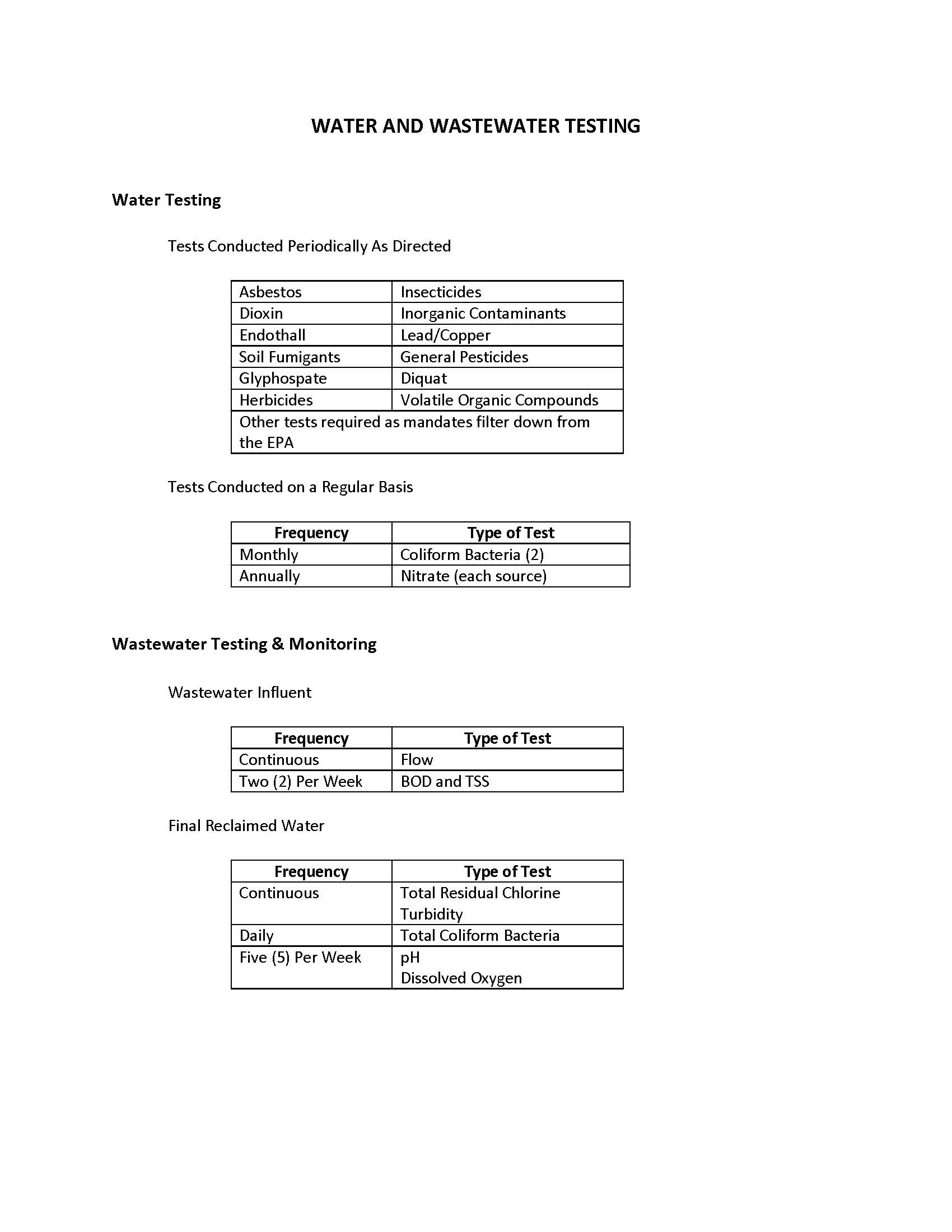
Cross-Connection and Backflow Prevention
See Cross Connection Program: Backflow Prevention Policy under Policies & Procedures. The following is a list of Backflow Assembly Testers that have submitted proof of certification to the SWD.
| BAT No. | Name | Contact Number | |||
|---|---|---|---|---|---|
| B7395 | Brett Romano | 360-808-6287 | |||
| Peninsula Water Solutions | peninsulawatersolutions.com | ||||
| B4365 | Zachary Panni | 360-801-1931 | |||
| Zach's Backflow Service | |||||
| B6870 | Timmy Wright | 360-460-0786 | |||
| Wright's Backflow Service |

SunLand Water District Elections
Every two years, registered voters in the SunLand Water District elect one of our three Commissioners in the general election to serve staggered six-year terms. At the November 2023 election, John Lewis was elected for a six-year term. The next election for a SunLand commissioner will occur in 2025. If you are interested in serving your community, here is some information that will be of interest to you.
Eligibility:
A candidate must reside in SunLand and be registered to vote in a SunLand precinct. There are no district boundaries. The law makes no distinction between property owners and renters. Conversely, a SunLand property owner not registered to vote in a SunLand precinct is not eligible.
Compensation:
State statute allows compensation at a maximum of $161 per meeting.
Duties and Responsibilities:
Commissioners swear to uphold the laws of the state and nation. Specific duties pertaining to SWD functions, policies and procedures are decided and assigned by the Board President and the entire board. The Board has oversight on all District programs and policies and full fiduciary responsibility.
A SWD commissioner would be expected to attend monthly meetings usually held the morning of the third Tuesday of the month. There are also special meetings called to discuss or decide issues that won’t wait for the next regular meeting, or if a regular meeting must be held on a non-regular date. In addition, a commissioner needs to be available to residents and district staff on a regular basis.
A commissioner would be expected to interface with staff at all levels and be involved with off-site activities relevant to SWD. These might include, but not be limited to, contact with the City of Sequim and Clallam County officials and Washington Association of Water and Sewer District functions.
Filing for Candidacy:
It is necessary to file an application with the County Elections Department. Filing week occurs in May every two years. Interested parties may file for candidacy in person, by mail, or online. Please contact Clallam County Auditor’s Office in the Clallam County Courthouse building at 223 E. 4th Street, Suite 042, Port Angeles, WA 98362, 360-417-2221. Additional information and filing forms may be found online at the Clallam County Auditor’s website. Besides the application for office you will be required to file a statement with the Washington State Financial Disclosure Commission. This can be done electronically.

Washington State Regulations
The 2003 Municipal Water Supply-Efficiency Requirements Act
(Commonly known as the Washington “Municipal Water Law”)
This law provides water utilities with certainty and flexibility in the exercise of water rights while establishing reasonable and achievable water use efficiency requirements. It applies to all municipal water suppliers with 15 or more connections.
Managing water efficiently can help water utilities decrease expenses and extend the life of water system components.
Monitoring the amount of water produced and used can help identify leaks and needed repairs. Leaks are a major problem—and a special concern because of the possibility of bacteria or other contaminants getting into water and possibly causing illness.
Key elements of the Water Use Efficiency Rule:
a. Water Use Efficiency Planning. Water suppliers must collect data, forecast demand, evaluate leakage, evaluate rate structures that encourage water use efficiency, and evaluate or implement water use efficiency measures.
b. Distribution Leakage Standard. Municipal water suppliers must meet a state distribution system leakage standard in order to minimize water loss in the distribution system.
c. Water Use Efficiency Goal-Setting and Performance Reporting. Municipal water suppliers must set water use efficiency goals through a public process and report annually on their performance to customers.
For more information, visit:
![]() Washington State Department of Health – Water Use Efficiency
Washington State Department of Health – Water Use Efficiency ![]()
This is the law that requires all customers to be metered by 2017.
Water-Sewer Districts – Title 57, Revised Code of Washington
This Title of State of Washington Legal Code governs the formation and operation of municipal water districts – including SunLand Water District. It’s various chapters spell out the way we must operate the district’s activities.
For more information, visit:
![]() Washington State Legislature
Washington State Legislature ![]()
Title 57 of the Revised Code of Washington which pertains to water and sewer districts.
2024 Consumer Confidence Report
The District
The SunLand Water District is pleased to provide you with our Annual Consumer Confidence Report for 2024. This report summarizes information about our water source, water quality, the systems required to deliver safe, great-tasting water, and the team that makes it happen.
The SunLand Water District is a municipal corporation, governed by three commissioners who serve a six-year staggered term. The Board of Commissioners meets every third Tuesday of the month at 9:00 am. The daily operations team consists of a part-time district manager, a clerk/bookkeeper, an office administrator, four full-time, and two part-time operators. The district also operates and maintains the SunLand Water Reclamation Facility.
The district provides water to approximately 907 residential service lines within the boundaries of Sunland, and another 15 residential service lines to the adjacent Southern View Estates community. If you have any questions about this report, or questions concerning the district, please contact the District Manager at 360.683.3905
Source Water
Water is provided to the community via two groundwater wells, located within the district. The water supplied from the two wells is not treated. No chemicals are added and there is no filtration. The upper well (#S01) is 250 feet deep and produces about 500 gallons per minute. It is located within a residential neighborhood at 187 Sunset Place. This well has an adjacent 110,000 gallon above-ground storage reservoir and a booster pump station which ensures adequate pressure throughout the district. The lower well (#S02) is 123 feet deep, produces 600 gallons per minute and is located at 5762 Woodcock Road, adjacent the SunLand RV storage facility. Following Washington State’s Department of Health Sanitary Survey in July 2023, we determined, as a precautionary move to further protect the well, to reassign new storage spaces to all gas-powered RVs. The relocation of RV’s was accomplished with the full cooperation of the SunLand Owners’ Association, who own and manage the storage lot. The lower well also has an adjacent 130,000 gallon above-ground reservoir, and a booster pump station. Each site is inspected daily for possible sources of contamination, the meters are read, and equipment is inspected. Emergency generators at each site provide backup power during a power outage.
Water travels through 11 miles of distribution pipes to all residents. SunLand water is moderately hard at 170 mg/L, or 10 grains per gallon calcium carbonate. (CaC03). Either of the two wells, and reservoirs, is capable of supplying the entire district in an emergency situation. The supply wells, reservoirs, and distribution system did well in all aspects of the Washington State Department of Health Sanitary Survey conducted on July 21, 2023. (For more information, please reach out to the District Office Manager.
The SunLand Water District has a senior water right which ensures that we have more than an adequate supply of water now, and for the foreseeable future. All water services are metered and read monthly. The SunLand community is almost built out with fewer than 35 lots available.
Water Quality
Some people may be more vulnerable to contaminants in drinking water than the general public. Immuno-compromised persons, such as persons undergoing chemotherapy, persons who have undergone organ transplants, people with HIV/AIDS or other immune system disorders, some elderly, and infants can be particularly at risk from infections. These people should seek advice about drinking water from their health care providers.
The water produced from the two wells here in SunLand is very high quality. A majority of the water treatment plants in the State of Washington fail to match the quality of our two wells here in the district. We are fortunate to have such a high-quality source coming from the Olympic mountains.
This year the district implemented a series of weekly/monthly water quality tests in a preemptive move to ensure our source well water exceeds our required monitoring schedule in the distribution system. Well tests including pH, turbidity, and coliform testing are conducted weekly and monthly.
Water Quality Definitions
AL – Action Level: The concentration of a contaminant which, if exceeded, triggers treatment or other requirements that a water system must follow.
MCL – Maximum Contaminant Level: The highest level of a contaminant that is allowed in drinking water. MCLs are set as close to the MCLGs as feasible using the best available treatment technology.
MCLG – Maximum Contaminant Level Goal: The level of a contaminant in drinking water below which there is no known or expected risk to health. MCLGs allow for a margin of safety.
mg/L – milligram per Liter. Measurement used to determine contaminant level in water. 1 mg/L equals 1 gallon of contaminant in 1 million gallons of water.
ND– Non- Detected, NE – Not evaluated – Contaminants not found.
ng/L – nanogram per Liter or parts per trillion. Measurement used in PFAS testing. 1 ng/L equals one gallon of contaminant per trillion gallons of water.
NTU – Nephelometric Turbidity Units – Turbidity is the cloudiness or haziness of a fluid caused by large numbers of individual particles that are generally invisible to the naked eye. Color is water is also considered turbidity. The measurement of turbidity is a key test for both water clarity and water quality.
pH – pH is a quantitative measure of the acidity or basicity of aqueous or other liquid solutions. With a range of 0 -14 a pH of less than 7 means the substance is acidic, a pH over 7 means the substance is basic, and a pH of 7 means the subject is neutral.
PPM– Part per million: One part per million is equivalent to 1 gallon in 1 million gallons, one inch in 16 miles, 1 second in 11.5 days, or one minute in 2 years.
SAL – State action level.
SDRL – State detection reporting limit.
Trigger – Level where an investigation is initiated.
For more information about contaminants and potential health effects please contact the EPA’s Safe Drinking Water hotline at 800.426.4791
Water Quality Testing
Spectra Labs – Poulsbo, WA. Specialty State-certified testing performed for the district includes Lead & Copper, Asbestos, Complete Inorganic, Volatile Organics, Herbicides, Gross Alpha, & Radium 228 samples.
Clallam County Drinking Water Lab – Port Angeles WA. Monthly coliform testing, and annual nitrate testing.
Eurofins Eaton Analytical, Pomona, CA. – PFAS testing.
pH Testing – Both production wells are sampled weekly and tested by a water distribution operator. Weekly pH samples can provide valuable early information on possible well contamination.
Turbidity (NTU) – A water distribution operator weekly samples both production wells. Increasing turbidity levels can be an early indication of production well degradation.
Test Results
Lead samples analyzed by Spectra Labs Poulsbo WA. Sources, service lines, soldered indoor plumbing, brass fittings.
Lead – We collected 10 samples in July 2024 with results ranging from a low of ND to a high of 0.008mg/L – MCL for lead is 0.015.
Copper samples analyzed by Spectra Labs Poulsbo WA. Sources service lines, plumbing/ fittings.
Copper – We collected 10 copper samples in July 2024 with results ranging from a low of ND – to a high of 0.22 mg/L – MCL for copper is 1.3 mg/L.
Nitrate samples analyzed by Clallam County Drinking Water Lab, Port Angeles WA. Sources – Fertilizer, Runoff, Septic systems.
Nitrates – Tested 10/14/24 from reservoir # 1- Result – 3.25mg/L, Trigger – 5 mg/L, 10mg/L MCL.
Nitrates – Tested 10/14/24 from reservoir # 2 – Result – 2.97mg/L, Trigger – 5 mg/L, 10 mg/L MCL.
PFAS testing analyzed by Eurofins Eaton Analytical, Pomona CA. Sources – waterproof clothing, carpet, plastics, firefighting foam, and many other daily used items.
PFAS Upper Reservoir– Tested 09/03/24 – PFHxS 3.6 ng/L, MCL 65 ng/L – PFBS 2.0 ng/L, MCL 345 ng/L.
PFAS Lower Reservoir– Tested 09/03/24 – Non-Detectable
pH– Samples collected by distribution operators weekly resulted in an average pH of about 6.7 or slightly acidic.
Turbidity– Weekly samples collected by distribution operators resulted in an average of .10 NTU. MCL range .30 – 5.0 NTU depending on source water.
Coliform Tested by Clallam County Water Lab – Port Angeles, WA
Over the past year, the district collected 24 coliform bacterium samples. (Coliform is a bacterium that can be present in nature, and occurs in all human and animal waste. The bacterium itself is not considered harmful; however, it is an indicator of potential contamination). There are seven coliform sample sites located throughout the district. Collection of the two monthly samples is rotated monthly between these seven sites, and the number of samples collected is based on population served. We are required to collect two samples per month. All 24 coliform test results came back satisfactory.
We also implemented an in-house monthly coliform test of each production well to provide an early indication of well contamination. These samples also tested satisfactory.
Upcoming Testing
Coliform sampling – 2 Samples per month 2025
Nitrate – Reservoir 1 – Due October 2025
Nitrate – Reservoir 2- Due October 2025
Lead & Copper – Due August 2027. Sampled once every 3 years. Last sampled July 2024.
Volatile Organics (VOC) Due July 2025 Sampled once every 6 years. Last sampled 07/17/2019.
Asbestos – Due September 2027. Sampled once every 9 years. Last sampled 11/05/2018.
Complete Inorganic (IOC) Due August 2030 Sampled once every 9 years. Last sampled 08/24/21.
PFAS – We will conduct a series of follow up sampling in February 2025. EPA requirements. Last sampled August 2024.
Herbicides – Due July 2028. Last sampled 07/17/2019.
Gross Alpha – Due 08/24/25 Last Sampled 08/24/21.
Radium – Due 08/24/25 Last sampled 08/24/21.
Lead in Drinking Water
In the past year, the district has been tasked with identifying and removing any lead water service lines. Lead was commonly used for water service lines in the late 1800’s until the 1940’s. Luckily, the district was developed in the 1970’s so no such lines exist. In Washington State, lead in drinking water comes primarily from materials and components used in household plumbing. The more water sits in pipes, the more dissolved metals it may contain such as lead. Elevated levels of lead can cause serious health problems, especially in pregnant women and young children.
PFAS
PFAS, (Polyfluoroalkyl Substances), or more commonly known as the “forever chemical,” has been found throughout the world, and dates back to the 1930’s. It is most commonly found in fire- fighting foam used to extinguish fires. It is also common in water-repellent clothing, stain-proof furniture fabrics/carpets, non-stick pots and pans, and food packaging. The chemical has been used since the 1940’s, and is very difficult to eliminate. Due to the fact the district tested positive to trace amounts of PFAS in the upper reservoir, the EPA requires follow up sampling of both reservoirs scheduled for late February of this year. Results of those two tests will be included in the 2025 Consumer Confidence Report.
For more information on any specific contaminant not listed, please reach out to the district office and we can provide results and dates of the last analysis.
Water Operations
The water operations team works diligently each and every day to ensure we are providing safe, high-quality water to all residents. We strive to address all customer service requests in a timely and professional manner. Licenses held by district staff include Water Distribution Manager, Cross Control Specialist, and Water Treatment Plant Operator.
During the late winter months of each year, one reservoir is taken out of service at a time, and is cleaned, inspected, disinfected, and put back into service. This maintenance is usually completed in December-March before summer flows ramp up. The distribution crew begins a fire hydrant flushing program during the spring months. This practice flushes any possible sediment from the distribution lines, and ensures the freshest water in service areas with dead-end mainlines such as cul-de-sacs. During the summer months, all water mainline valves are exercised to ensure they are operable in the case of a break, or isolation is needed for a larger area. These are just a few of the many tasks performed throughout the year.
Our goal is to ensure that we meet, and exceed, all regulatory agency standards, and retain our consumer’s confidence in us to provide safe and reliable drinking water every time a faucet is opened.
Water Conservation Practices & Goals
- Between 2010 and 2017, the EPA and the Washington Department of Health required all public water systems to install water meters and record usage monthly. Even though the SunLand Water District bills on a flat annual rate, the results of conservation have been impressive. Listed below are some of the practices implemented.
- Detailed monthly meter reads has eliminated excess water from leaking toilet valves, leaking faucets, and broken sprinkler lines/heads to name a few.
- Making contact with habitual water abusers with recommendations where the waste might be occurring, how much water they are using monthly, and how best to remedy the over usage. Usually, it is an over-watering issue.
- Performing mainline and service line leak-detection surveys using leak-detection equipment.
- Communicating drought declarations and recommendations from the State via the district’s email.
- Posting water conservation recommendations twice yearly (spring/summer) on the district’s website; (e.g., shorter showers, full loads of laundry, full dishwashers, and watering in the early morning or later in the evening.)
Results from our water conservation efforts have been quite impressive. Keep in mind, unaccounted water/leakage for a small district should be 10% or less of the total metered consumption. For the year ending December 2022, our loss was 16%, year ending December 2023 our loss was 7%, and for the year ending December 2024 our loss was 3%.
With the understanding of the task at hand, cooperation of our customers, and the daily efforts of the distribution operators, we have met and exceeded our water use efficiency goals while preserving our most valuable resource. Thank you for all your contributions toward these goals.
Need to contact us?
SunLand Water District
5762 Woodcock Road
Sequim, Washington 98382
360.683.3905
Office Hours Monday through Friday: 9:00 a.m. – 1:00 p.m.
Download a PDF version here: Consumer Confidence Report

